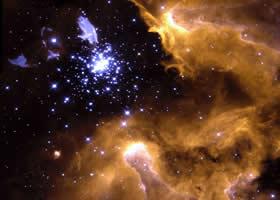The observations of PILOT have two major scientific objectives. On one hand, they will allow to constrain the large scale geometry of the magnetic field in our Galaxy and to study in details the alignment properties of dust grains with respect to the magnetic field. In this domain, the measurements of PILOT will be complementary with those of Planck at longer wavelengths and lower angular resolution. They will allow to better understand the role of the magnetic field in shaping the Inter-Stellar Medium (ISM) material on large scale in molecular clouds, and the role it plays in the gravitational collapse leading to star formation. On the other hand, the PILOT observations will allow to measure for the first time the polarized dust emission towards the most diffuse regions of the sky, where the measurements are the most easily interpreted in terms of the physics of the dust.
These measurements are of particular importance in the perspective of future cosmology experiments (such as EPIC: Einstein Probe for Inflationary Cosmology) which goal will be to measure the polarization of the Cosmological Microwave Background (CMB), in particular the B modes produced by tensorial perturbations. The detection of those would be an definitive proof of interaction with primordial gravitational waves generated during inflation, and would be a major step forward for cosmology and high energy physics. However, the detection of these modes will not be possible without a precise subtraction of the polarized foreground emissions, which are dominated by polarized dust emission at frequencies above 100 GHz. The sensitivity of the PILOT experiment (about 50 times that of Planck to a given ISM column density) will prefigure that of future cosmology experiments. The results of PILOT will allow to gain knowledge of the magnetic properties of dust grains and to the structure of the magnetic field in the diffuse ISM that will be necessary to a precise foreground subtraction. They will also allow to define the instrumental and technical choices for these future missions. In this particular domain, PILOT will play a similar role than the Archeops experiment for Planck.
Today, dust emission polarization measurments are scarce and suffer from important bias. Due to their low sensitivity, polarization measurements obtained from large telescops on the ground allow to probe only the brightest regions of the sky, in the immediate vicinity of tar forming regions. No other experiment (past or envisionned) than PILOT is optimized to detect polarized dust emission. No observational means will therefore allow a complete a systematic survey of the dust polarized emission in the near future. The PILOT experiment will take advantage of the large gain in sensitivity allowed by stratospheric altitudes and the use of large format bolometer arrays. PILOT will complement the many ground-based and ballon-born experiment which are currently developped to try measure the CMB polarization, and for which polarized foreground emission is often ignored. The PILOT measurments will also complement that of Planck in, the Far Infra-Red (FIR).
Science by-products :
PILOT will not only detect polarized dust emission, but will also detect the dust emission intensity at a very high accuracy. This will complement observations obtained earlier with the Pronaos experiment, Archeops and Planck. The PILOT measurements will allow to fill the wavelength gap between these experiments and the IRAS sky at arcminute scales. Scientific by-products will also include a large point-source catalog (several 1000 sources in 10 hrs).

